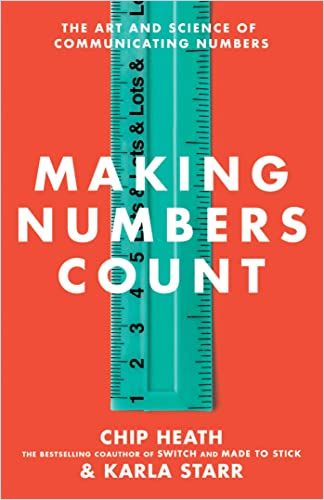Master explainers Chip Heath and Karla Starr explain how to explain numbers for greater comprehension, retention and enjoyment.

Uunderstanding Numbers
Stanford Business School professor Chip Heath and co-writer Karla Starr find that “nobody really understands numbers.” The human brain can’t recognize, at a glance, a number of items greater than five. However, when you translate numbers into analogies, comparisons and conversions, someone who struggles with simple arithmetic can easily grasp numbers. Heath and Starr’s clever, practical guide, teeming with fun examples, teaches basic principles that can improve how you understand and convey numbers in a world that is growing more number-dependent daily.
Up to Five
The human brain can recognize a number of objects up to five without counting them. Perceiving a greater number of items is tricky. In fact, several languages around the world lack words for numbers beyond five. The greater a number, the less real it feels. When people can’t envision what numbers represent, their decision-making suffers.
Almost every gnarly number has something – an analogy, a comparison, another dimension – that will allow us to translate it into something we can remember, use and discuss with others.Chip Heath and Karla Starr
Heath and Starr insist, however, that anyone can become number savvy. They provide techniques to improve your ability to understand, communicate and act on numbers.
Comparisons and Analogies
Translating numbers into something people understand improves their ability to remember. Sometimes the best way to convey a number is to omit it. Instead, craft a message that makes numbers redundant. For example, consider this comparison: In the United States, white job applicants convicted of a felony are more likely to get a job interview than are Black applicants with no criminal record. This stark comparison depicts racial inequality more persuasively than statistics could.
“Big-ism”
Dropping large numbers won’t communicate your point. People can picture the size of a bus, for example, but the size of a galaxy is too astronomical to comprehend.
Instead, convert a huge number into something people can easily grasp: For instance, to illustrate the difference between one million and one billion, consider that a million seconds equates to 12 days, but a billion seconds is 32 years.
Unfriendly Numbers
Unfriendly numbers – such as the fraction 17/139, a long decimal such as 0.092383 or a complicated number such as 4,954,287 – crash people’s working memory. Customers of the fast-food restaurant chain A&W, for example, thought its 1/3-pound burger was smaller than a competitor’s 1/4 pounder, because three is less than four. Prefer simple, concrete numbers, but defer to your own expertise. For example, though it may look like a complicated number, don’t round up a baseball player’s batting average.
Visual Representations
Nations used a variety of well-known objects to symbolize the recommended COVID-19 social distancing guideline. Canada used a hockey stick; France, two baguettes; California, a surfboard.
If you think you have a statistic that says something important, skip the middleware: Say the important thing directly. You want people to see and feel the numbers, not just read them.Chip Heath and Karla Starr
Doctors likewise describe tumor sizes in terms of fruits rather than centimeters, because people understand “grape-size” more readily than 3 cm.
Something Tangible
Heath and Starr recommend translating numbers into something tangible – like actions. For example, a single Pringle potato chip contains 10 calories; make this more meaningful by explaining that you have to walk the length of two football fields to burn off the calories of a Pringle potato chip.
The average human brain struggles to perceive the size of enormous things, such as Mount Everest’s height, or very small things, such as a molecule. Relay their sizes in terms of a human scale to make them comprehensible. For example, if you were the height of a pencil eraser, Mount Everest would be as tall as a 7.5-story building.
When the Ever Given cargo ship blocked the Suez Canal, the media compared its length to the height of the Empire State Building. Superlatives also make a strong point. For example, the Nile is the world’s longest river, and the Amazon River holds has the greatest volume of water. Pointing out that the Amazon has more water volume than the next 11 biggest rivers combined makes its scale more apparent.
If you can simultaneously follow your emotions and the numbers, you can bridge worlds.Chip Heath and Karla Starr
“Category jumpers” appeal to emotions. To illustrate California’s economic heft, for example, explain that, if the state were an independent nation, it would be the fifth-largest economy in the world. And if the world’s population of cows formed a country, it would be the third-highest producer of greenhouse gases.
Personalize Abstract Numbers
Making data personal increases people’s recall and understanding, say Heath and Starr. For example, law school professors say, “Look to your left. Look to your right. One of the three of you won’t be joining us next fall.” Students then sense the 33% law school dropout rate in the pit of their stomachs.
All data is more engaging if people can use it to imagine themselves taking action and reaping the benefits (or paying the costs) of their actions.Chip Heath and Karla Starr
Clap your hands as fast as you can for one second. Most people can clap four times. The clap exercise demonstrates the difference between the first-place Olympic runner in the 200-meter dash and, on the third clap, the runner placing eighth.
Landmarks and Time
Heath and Starr suggest providing landmarks to help your audience navigate a concept. For example, a doctor informed a patient that normal platelet counts range between 150,000 and 450,000 per microliter of blood. This anchor helped the patient understand that her 40,000 count meant she was in risky territory.
Time also works as a navigation tool. For example, if you frame the history of the universe as a single day, dinosaurs didn’t roam the Earth until 11:37 p.m., and human beings didn’t show up until a portion of the last second.
Clearing the Fog
Chip Heath has built a career of clarifying everyday cogitation few people want to admit they need help clarifying. He and Karla Starr prove worthy explainers, writing with clarity, wit, short sentences, fun examples and zero condescension. They emphasize that numbers confuse them, too, and that they, like their readers, fight for comprehension in a numeric fog. The authors may pad here and there to achieve a book-length page count, but you will welcome their explanations.
Chip Heath co-authored Made to Stick; Switch; and The Power of Moments. Karla Starr also wrote Can You Learn to Be Lucky?












